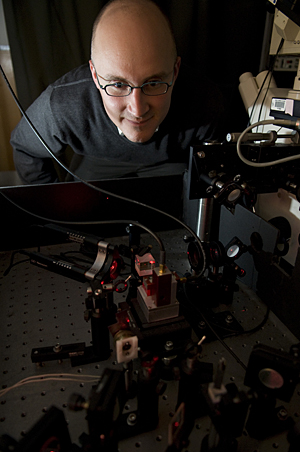Home > Press > Chemical engineering professor awarded two grants to investigate directed self-assembly
 |
| Eric Furst |
Abstract:
Eric Furst, associate professor in the Department of Chemical Engineering at the University of Delaware, has received two grants totaling $727,000 for his work on directed self-assembly of soft materials.
Chemical engineering professor awarded two grants to investigate directed self-assembly
Newark, DE | Posted on October 20th, 2009The National Science Foundation (NSF) has awarded Furst $292,000 to investigate interactions and self-assembly of anisotropic colloidal particles in electric fields, while the Department of Energy (DOE) has granted him $435,000 to study directed self-assembly of nanodispersions.
Soft materials, which are neither crystalline solids nor simple liquids but lie somewhere in between, include soaps, paints, gels, plastics, glues, and biological tissues.
"Biological systems have provided us with the inspiration to engineer modern soft materials using self-assembly," Furst explains. "We're using the same principles to manipulate and control the interactions of colloidal particles and other building blocks so that they spontaneously organize themselves into structures that perform a desired function."
According to Furst, directed self-assembly is especially important for the development of nanotechnology, and his two recent grants are an outgrowth of previous funding to a group of faculty in the UD Department of Chemical Engineering through NSF's Nanotechnology and Interdisciplinary Research Team (NIRT) program.
"Engineering micro- to nanoscale devices and nanostructured materials requires control and understanding of the thermodynamics and kinetics of self-assembly of nanoscale building blocks in solution," he says.
One approach to providing that control is to use electric fields to guide the process in a particular way. The new NSF grant will support work addressing that issue, with a particular focus on unusual particles known as doublets, which resemble two spheres pushed together.
"We're interested in seeing how these particles polarize in an electric field and how their shape affects their ability to form a structure," Furst says. "The work promises to give us new insights into directed self-assembly."
The DOE project will be directed toward how the technology can be used to harvest soft materials for energy applications.
Article by Diane Kukich
Photo by Doug Baker
####
About University of Delaware
The University of Delaware has a great tradition of excellence, from our founding as a small private academy in 1743, to the research-intensive, technologically advanced institution of today.
Our alumni tell our story of achievement, from our first class, which included three signers of the Declaration of Independence and one signer of the U.S. Constitution, to the more than 140,000 living Blue Hens who are making vital contributions to the world--in science, business, education, the arts, policy, health care, the environment, and many other areas. Vice President Joseph R. Biden Jr. and his wife, Jill, are both UD alumni.
The University received its charter from the State of Delaware in 1833 and was designated one of the nation’s historic Land Grant colleges in 1867. Today, UD is a Land Grant, Sea Grant and Space Grant institution. UD also is classified by the Carnegie Foundation for the Advancement of Teaching as a research university with very high research activity--a designation accorded to less than 3 percent of U.S. colleges and universities.
For more information, please click here
Contacts:
Phone: (302) 831-2792
www.udel.edu/ocm
Copyright © University of Delaware
If you have a comment, please Contact us.Issuers of news releases, not 7th Wave, Inc. or Nanotechnology Now, are solely responsible for the accuracy of the content.
| Related News Press |
News and information
![]() Researchers develop molecular qubits that communicate at telecom frequencies October 3rd, 2025
Researchers develop molecular qubits that communicate at telecom frequencies October 3rd, 2025
![]() Next-generation quantum communication October 3rd, 2025
Next-generation quantum communication October 3rd, 2025
![]() "Nanoreactor" cage uses visible light for catalytic and ultra-selective cross-cycloadditions October 3rd, 2025
"Nanoreactor" cage uses visible light for catalytic and ultra-selective cross-cycloadditions October 3rd, 2025
Self Assembly
![]() Diamond glitter: A play of colors with artificial DNA crystals May 17th, 2024
Diamond glitter: A play of colors with artificial DNA crystals May 17th, 2024
![]() Liquid crystal templated chiral nanomaterials October 14th, 2022
Liquid crystal templated chiral nanomaterials October 14th, 2022
![]() Nanoclusters self-organize into centimeter-scale hierarchical assemblies April 22nd, 2022
Nanoclusters self-organize into centimeter-scale hierarchical assemblies April 22nd, 2022
![]() Atom by atom: building precise smaller nanoparticles with templates March 4th, 2022
Atom by atom: building precise smaller nanoparticles with templates March 4th, 2022
Announcements
![]() Rice membrane extracts lithium from brines with greater speed, less waste October 3rd, 2025
Rice membrane extracts lithium from brines with greater speed, less waste October 3rd, 2025
![]() Researchers develop molecular qubits that communicate at telecom frequencies October 3rd, 2025
Researchers develop molecular qubits that communicate at telecom frequencies October 3rd, 2025
![]() Next-generation quantum communication October 3rd, 2025
Next-generation quantum communication October 3rd, 2025
![]() "Nanoreactor" cage uses visible light for catalytic and ultra-selective cross-cycloadditions October 3rd, 2025
"Nanoreactor" cage uses visible light for catalytic and ultra-selective cross-cycloadditions October 3rd, 2025
Grants/Sponsored Research/Awards/Scholarships/Gifts/Contests/Honors/Records
![]() Researchers tackle the memory bottleneck stalling quantum computing October 3rd, 2025
Researchers tackle the memory bottleneck stalling quantum computing October 3rd, 2025
![]() New discovery aims to improve the design of microelectronic devices September 13th, 2024
New discovery aims to improve the design of microelectronic devices September 13th, 2024
![]() Physicists unlock the secret of elusive quantum negative entanglement entropy using simple classical hardware August 16th, 2024
Physicists unlock the secret of elusive quantum negative entanglement entropy using simple classical hardware August 16th, 2024
|
|
||
|
|
||
| The latest news from around the world, FREE | ||
|
|
||
|
|
||
| Premium Products | ||
|
|
||
|
Only the news you want to read!
Learn More |
||
|
|
||
|
Full-service, expert consulting
Learn More |
||
|
|
||








